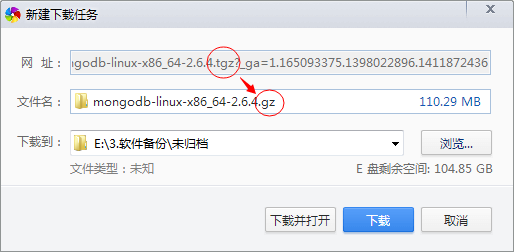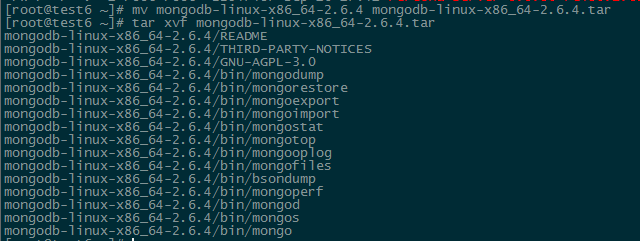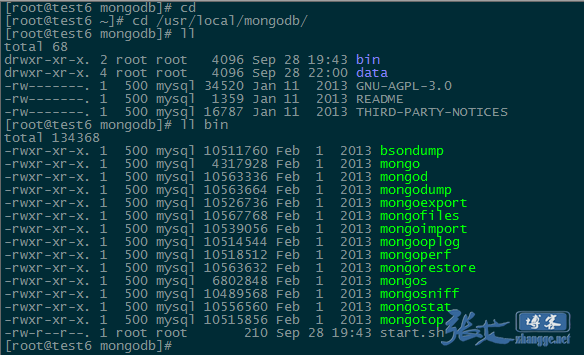Mongo DB ,是目前在IT行業非常流行的一種非關系型數據庫(NoSql),其靈活的數據存儲方式,備受當前IT從業人員的青睐。Mongo DB很好的實現了面向對象的思想(OO思想),在Mongo DB中 每一條記錄都是一個Document對象。Mongo DB最大的優勢在於所有的數據持久操作都無需開發人員手動編寫SQL語句,直接調用方法就可以輕松的實現CRUD操作。
一、下載mongodb
前往mongodb官網下載頁面:https://www.mongodb.org/downloads下載相應的版本,比如目前的Linux x64位最新版:mongodb-linux-x86_64-2.6.4.tgz
不過有點坑爹是,下載鏈接明明是tgz格式,結果下載後變成了gz格式:

先下載看看好了。
二、解壓mongodb
[root@test6 ~]# gzip -d mongodb-linux-x86_64-2.6.4.gz
得到的是mongodb-linux-x86_64-2.6.4,居然是個文件,而不是文件夾,和網上說的大相徑庭:

看來前面下載的確實存在問題!實際上應該是tgz文件才對,按經驗分析了一下,下載的實際上還是tgz文件,顯示為gz文件只是形式上的假象!所以,gzip只解壓了壓縮包的外層,實際上還需要解壓一層tar存檔屬性!
於是,先將解壓後的文件重命名加上tar格式:
[root@test6 ~]# mv mongodb-linux-x86_64-2.6.4 mongodb-linux-x86_64-2.6.4.tar
然後,使用tar解壓即可:
[root@test6 ~]# tar xvf mongodb-linux-x86_64-2.6.4.tar

將解壓後的文件夾移動&重命名至/usr/local/mongodb
[root@test6 ~]# mv mongodb-linux-x86_64-2.6.4 /usr/local/mongodb [root@test6 ~]# cd /usr/local/mongodb/bin/ [root@test6 ~]# ll

bin下的mongod就是MongoDB的服務端進程,mongo就是其客戶端,其它的命令用於MongoDB的其它用途如MongoDB文件導出等。
三、啟動mongodb
啟動前,先指定mongodb的data目錄,如果沒有就創建一個:
[root@test6 ~]# cd /usr/local/mongodb [root@test6 mongodb]# mkdir data
然後,執行如下命令即可啟動mongodb:
[root@test6 mongodb]# /usr/local/mongodb/bin/mongod --dbpath=/usr/local/mongodb/data/ --logpath=/usr/local/mongodb/data/mongodb.log --logappend&

啟動成功後,可查看是否啟動成功了,默認端口號是27017,當然在啟動時也可以指定未使用的其它端口。

最後,將客戶端mogo文件在/bin下軟鏈接,方便隨處執行:
ln -s /usr/local/mongodb/bin/mongo /bin/mongo

現在使用mongo客戶端訪問一下該數據庫:
[root@test6 bin]# ./mongo MongoDB shell version: 2.6.4 connecting to: test >
安裝成功!
四、附:基本操作
MongoDB數據庫基本用法
show dbs:顯示數據庫列表
show collections:顯示當前數據庫中的集合(類似關系數據庫中的表)
show users:顯示用戶
use <db name>:切換當前數據庫,這和MS-SQL裡面的意思一樣
db.help():顯示數據庫操作命令,裡面有很多的命令
db.foo.help():顯示集合操作命令,同樣有很多的命令,foo指的是當前數據庫下,一個叫foo的集合,並非真正意義上的命令
db.foo.find():對於當前數據庫中的foo集合進行數據查找(由於沒有條件,會列出所有數據)
db.foo.find( { a : 1 } ):對於當前數據庫中的foo集合進行查找,條件是數據中有一個屬性叫a,且a的值為1
MongoDB沒有創建數據庫的命令,但有類似的命令。
如:如果你想創建一個“myTest”的數據庫,先運行use myTest命令,之後就做一些操作(如:db.createCollection('user')),這樣就可以創建一個名叫“myTest”的數據庫。
數據庫常用命令
1、Help查看命令提示
help
db.help();
db.yourColl.help();
db.youColl.find().help();
rs.help();
2、切換/創建數據庫
use yourDB; 當創建一個集合(table)的時候會自動創建當前數據庫
3、查詢所有數據庫
show dbs;
4、刪除當前使用數據庫
db.dropDatabase();
5、從指定主機上克隆數據庫
db.cloneDatabase(“127.0.0.1”); 將指定機器上的數據庫的數據克隆到當前數據庫
6、從指定的機器上復制指定數據庫數據到某個數據庫
db.copyDatabase("mydb", "temp", "127.0.0.1");將本機的mydb的數據復制到temp數據庫中
7、修復當前數據庫
db.repairDatabase();
8、查看當前使用的數據庫
db.getName();
db; db和getName方法是一樣的效果,都可以查詢當前使用的數據庫
9、顯示當前db狀態
db.stats();
10、當前db版本
db.version();
11、查看當前db的鏈接機器地址
db.getMongo();
Collection聚集集合
1、創建一個聚集集合(table)
db.createCollection(“collName”, {size: 20, capped: 5, max: 100});
2、得到指定名稱的聚集集合(table)
db.getCollection("account");
3、得到當前db的所有聚集集合
db.getCollectionNames();
4、顯示當前db所有聚集索引的狀態
db.printCollectionStats();
用戶相關
1、添加一個用戶
db.addUser("name");
db.addUser("userName", "pwd123", true); 添加用戶、設置密碼、是否只讀
2、數據庫認證、安全模式
db.auth("userName", "123123");
3、顯示當前所有用戶
show users;
4、刪除用戶
db.removeUser("userName");
其他
1、查詢之前的錯誤信息
db.getPrevError();
2、清除錯誤記錄
db.resetError();
查看聚集集合基本信息
1、查看幫助 db.yourColl.help();
2、查詢當前集合的數據條數 db.yourColl.count();
3、查看數據空間大小 db.userInfo.dataSize();
4、得到當前聚集集合所在的db db.userInfo.getDB();
5、得到當前聚集的狀態 db.userInfo.stats();
6、得到聚集集合總大小 db.userInfo.totalSize();
7、聚集集合儲存空間大小 db.userInfo.storageSize();
8、Shard版本信息 db.userInfo.getShardVersion()
9、聚集集合重命名 db.userInfo.renameCollection("users"); 將userInfo重命名為users
10、刪除當前聚集集合 db.userInfo.drop();
聚集集合查詢
1、查詢所有記錄
db.userInfo.find();
相當於:select* from userInfo;
默認每頁顯示20條記錄,當顯示不下的情況下,可以用it迭代命令查詢下一頁數據。注意:鍵入it命令不能帶“;”
但是你可以設置每頁顯示數據的大小,用DBQuery.shellBatchSize= 50;這樣每頁就顯示50條記錄了。
2、查詢去掉後的當前聚集集合中的某列的重復數據
db.userInfo.distinct("name");
會過濾掉name中的相同數據
相當於:select distict name from userInfo;
3、查詢age = 22的記錄
db.userInfo.find({"age": 22});
相當於: select * from userInfo where age = 22;
4、查詢age > 22的記錄
db.userInfo.find({age: {$gt: 22}});
相當於:select * from userInfo where age >22;
5、查詢age < 22的記錄
db.userInfo.find({age: {$lt: 22}});
相當於:select * from userInfo where age <22;
6、查詢age >= 25的記錄
db.userInfo.find({age: {$gte: 25}});
相當於:select * from userInfo where age >= 25;
7、查詢age <= 25的記錄
db.userInfo.find({age: {$lte: 25}});
8、查詢age >= 23 並且 age <= 26
db.userInfo.find({age: {$gte: 23, $lte: 26}});
9、查詢name中包含 mongo的數據
db.userInfo.find({name: /mongo/});
//相當於%%
select * from userInfo where name like ‘%mongo%';
10、查詢name中以mongo開頭的
db.userInfo.find({name: /^mongo/});
select * from userInfo where name like ‘mongo%';
11、查詢指定列name、age數據
db.userInfo.find({}, {name: 1, age: 1});
相當於:select name, age from userInfo;
當然name也可以用true或false,當用ture的情況下河name:1效果一樣,如果用false就是排除name,顯示name以外的列信息。
12、查詢指定列name、age數據, age > 25
db.userInfo.find({age: {$gt: 25}}, {name: 1, age: 1});
相當於:select name, age from userInfo where age >25;
13、按照年齡排序
升序:db.userInfo.find().sort({age: 1});
降序:db.userInfo.find().sort({age: -1});
14、查詢name = zhangsan, age = 22的數據
db.userInfo.find({name: 'zhangsan', age: 22});
相當於:select * from userInfo where name = ‘zhangsan' and age = ‘22';
15、查詢前5條數據
db.userInfo.find().limit(5);
相當於:selecttop 5 * from userInfo;
16、查詢10條以後的數據
db.userInfo.find().skip(10);
相當於:select * from userInfo where id not in (
selecttop 10 * from userInfo
);
17、查詢在5-10之間的數據
db.userInfo.find().limit(10).skip(5);
可用於分頁,limit是pageSize,skip是第幾頁*pageSize
18、or與 查詢
db.userInfo.find({$or: [{age: 22}, {age: 25}]});
相當於:select * from userInfo where age = 22 or age = 25;
19、查詢第一條數據
db.userInfo.findOne();
相當於:selecttop 1 * from userInfo;
db.userInfo.find().limit(1);
20、查詢某個結果集的記錄條數
db.userInfo.find({age: {$gte: 25}}).count();
相當於:select count(*) from userInfo where age >= 20;
21、按照某列進行排序
db.userInfo.find({***: {$exists: true}}).count();
相當於:select count(***) from userInfo;
索引
1、創建索引
db.userInfo.ensureIndex({name: 1});
db.userInfo.ensureIndex({name: 1, ts: -1});
2、查詢當前聚集集合所有索引
db.userInfo.getIndexes();
3、查看總索引記錄大小
db.userInfo.totalIndexSize();
4、讀取當前集合的所有index信息
db.users.reIndex();
5、刪除指定索引
db.users.dropIndex("name_1");
6、刪除所有索引索引
db.users.dropIndexes();
修改、添加、刪除集合數據
1、添加
db.users.save({name: ‘zhangsan', age: 25, ***: true});
添加的數據的數據列,沒有固定,根據添加的數據為准
2、修改
db.users.update({age: 25}, {$set: {name: 'changeName'}}, false, true);
相當於:update users set name = ‘changeName' where age = 25;
db.users.update({name: 'Lisi'}, {$inc: {age: 50}}, false, true);
相當於:update users set age = age + 50 where name = ‘Lisi';
db.users.update({name: 'Lisi'}, {$inc: {age: 50}, $set: {name: 'hoho'}}, false, true);
相當於:update users set age = age + 50, name = ‘hoho' where name = ‘Lisi';
3、刪除
db.users.remove({age: 132});
4、查詢修改刪除
db.users.findAndModify({
query: {age: {$gte: 25}},
sort: {age: -1},
update: {$set: {name: 'a2'}, $inc: {age: 2}},
remove: true
});
db.runCommand({ findandmodify : "users",
query: {age: {$gte: 25}},
sort: {age: -1},
update: {$set: {name: 'a2'}, $inc: {age: 2}},
remove: true
});
update 或 remove 其中一個是必須的參數; 其他參數可選。
參數
詳解
默認值
query
查詢過濾條件
{}
sort
如果多個文檔符合查詢過濾條件,將以該參數指定的排列方式選擇出排在首位的對象,該對象將被操作
{}
remove
若為true,被選中對象將在返回前被刪除
N/A
update
一個 修改器對象
N/A
new
若為true,將返回修改後的對象而不是原始對象。在刪除操作中,該參數被忽略。
false
fields
參見Retrieving a Subset of Fields (1.5.0+)
All fields
upsert
創建新對象若查詢結果為空。 示例 (1.5.4+)
false
語句塊操作
1、簡單Hello World
print("Hello World!");
這種寫法調用了print函數,和直接寫入"Hello World!"的效果是一樣的;
2、將一個對象轉換成json
tojson(new Object());
tojson(new Object('a'));
3、循環添加數據
> for (var i = 0; i < 30; i++) {
... db.users.save({name: "u_" + i, age: 22 + i, ***: i % 2});
... };
這樣就循環添加了30條數據,同樣也可以省略括號的寫法
> for (var i = 0; i < 30; i++) db.users.save({name: "u_" + i, age: 22 + i, ***: i % 2});
也是可以的,當你用db.users.find()查詢的時候,顯示多條數據而無法一頁顯示的情況下,可以用it查看下一頁的信息;
4、find 游標查詢
>var cursor = db.users.find();
> while (cursor.hasNext()) {
printjson(cursor.next());
}
這樣就查詢所有的users信息,同樣可以這樣寫
var cursor = db.users.find();
while (cursor.hasNext()) { printjson(cursor.next); }
同樣可以省略{}號
5、forEach迭代循環
db.users.find().forEach(printjson);
forEach中必須傳遞一個函數來處理每條迭代的數據信息
6、將find游標當數組處理
var cursor = db.users.find();
cursor[4];
取得下標索引為4的那條數據
既然可以當做數組處理,那麼就可以獲得它的長度:cursor.length();或者cursor.count();
那樣我們也可以用循環顯示數據
for (var i = 0, len = c.length(); i < len; i++) printjson(c[i]);
7、將find游標轉換成數組
> var arr = db.users.find().toArray();
> printjson(arr[2]);
用toArray方法將其轉換為數組
8、定制我們自己的查詢結果
只顯示age <= 28的並且只顯示age這列數據
db.users.find({age: {$lte: 28}}, {age: 1}).forEach(printjson);
db.users.find({age: {$lte: 28}}, {age: true}).forEach(printjson);
排除age的列
db.users.find({age: {$lte: 28}}, {age: false}).forEach(printjson);
9、forEach傳遞函數顯示信息
db.things.find({x:4}).forEach(function(x) {print(tojson(x));});
參考文章①:http://blog.csdn.net/ssyan/article/details/6927307
參考文章②:http://blog.chinaunix.net/uid-26558059-id-3211264.html